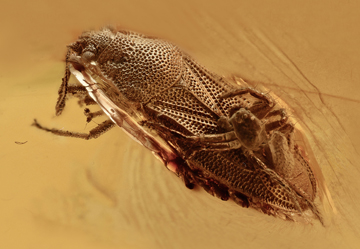Abstract
Falsiformicidae are found to belong to Vespoidea s.l. and not to Chrysidoidea because of sexually dimorphic antennae (12-segmented in female and 13-segmented in male) and permanently internalized female tergum 7. Eight described species in three genera are known in the family including five new species (Siccibythus oculatus sp. nov., S. pallidus sp. nov., S. martynovae sp. nov., S. ohmkuhnlei sp. nov., S. paulus sp. nov.) as well as a number of undescribed ones, all from mid-Cretaceous ambers (mostly of Kachin in Myanmar but also of Charente in France and Agapa in North Siberia). Phylogenetic affinities of Falsiformicidae within Vespoidea are left to be clarified, and biology of this family is enigmatic yet.
References
Branstetter, M.G., Danforth, B.N., Pitts, J.P., Faircloth, B.C., Ward, P.S., Buffington, M.L., Gates, M.W., Kula, R.R. & Brady, S.G. (2017) Phylogenomic insights into the evolution of stinging wasps and the origins of ants and bees. Current Biology, 27, 1019–1025.
https://doi.org/10.1016/j.cub.2017.03.027
Cockx, P.F.D. & McKellar, R.C. (2016) First record of the family Scolebythidae (Hymenoptera) in mid-Cretaceous amber from Myanmar. Cretaceous Research, 67, 133–139.
https://doi.org/10.1016/j.cretres.2016.06.015
Evans, H.E. (1973) Cretaceous aculeate wasps from Taimyr, Siberia (Hymenoptera). Psyche, 80, 166–178.
https://doi.org/10.1155/1973/16876
Heraty, J., Ronquist, F., Carpenter, J.M., Hawks, D., Schulmeister, S., Dowling, A.P., Murray, D., Munro, J., Wheeler, W.C., Schiff, N. & Sharkey, M. (2011) Evolution of the hymenopteran megaradiation. Molecular Phylogenetics and Evolution, 60, 73–88.
https://doi.org/10.1016/j.ympev.2011.04.003
Johnson, B.R., Borowiec, M.L., Chiu, J.C., Lee, E.K., Atallah, J. & Ward, P.S. (2013) Phylogenomics resolves evolutionary relationships among ants, bees, and wasps. Current Biology, 23, 2058–2062.
https://doi.org/10.1016/j.cub.2013.08.050
Klopfstein, S., Vilhelmsen, L., Heraty, J.M., Sharkey, M. & Ronquist, F. (2013) The hymenopteran tree of life: evidence from protein-coding genes and objectively aligned ribosomal data. PLoS ONE, 8 e69344.
https://doi.org/10.1371/journal.pone.0069344
Lak, M., Néraudeau, D., Nel, A., Cloetens, P., Perrichot, V. & Tafforeau, P. (2008) Phase contrast X-Ray synchrotron imaging: ppening access to fossil inclusions in opaque amber. Microscopy and Microanalysis, 14, 251–259.
https://doi.org/10.1017/S1431927608080264
Lelej, A.S. & Mokrousov, M.V. (2015) Sierolomorpha sogdiana spec. nov. from Central Asia, and a World catalogue of Sierolomorphidae (Hymenoptera). Zootaxa, 4018, 593–599.
https://doi.org/10.11646/zootaxa.4018.4.8
Nieves-Aldrey, J.L. & Sharkey, M (2014) Hymenopterans: ants, bees, wasps, and the majority of insect parasitoids. In: Vargas, P. & Zardoya, R. (Eds). The Tree of Life: Evolution and classification of living organisms. Chapter 33. Sunderland, MA: Sinauer Associates, pp. 394–406.
Payne, A., Barden, P.M., Wheeler, W.C. & Carpenter, J.M. (2013) Direct optimization, sensitivity analysis, and the evolution of the hymenopteran superfamilies. American Museum Novitates, No. 3789, 1–19.
https://doi.org/10.1206/3789.1
Perrichot, V., Engel, M.S., Nel, A., Ortega-Blanco, J., Delclòs, X., Soriano, C., Lohrmann, V. & Tafforeau, P. (2014) “False ants” from the Cretaceous (Hymenoptera: Chrysidoidea: Falsiformicidae). Mitteilungen des Entomologischen Vereins Stuttgart, 49, 26.
Peters, R.S., Krogmann, L., Mayer, C., Donath, A., Gunkel, S., Meusemann, K., Kozlov, A., Podsiadlowski, L., Petersen, M., Lanfear, R., Diez, P.A., Heraty, J., Kjer, K.M., Klopfstein, S., Meier, R., Polidori, C., Schmitt, T., Liu, S., Zhou, X., Wappler, T., Rust, J., Misof, B. & Niehuis, O. (2017) Evolutionary history of the Hymenoptera. Current Biology, 27, 1013–1018.
https://doi.org/10.1016/j.cub.2017.01.027
Rasnitsyn, A.P. (1969) Origin and evolution of the lower Hymenoptera. Transaction of the Paleontological Institute, Academy of Sciences of the USSR, 123, 1–196. [In Russian; English translation in 1979 by Amerind Publ. Co., New Delhi].
Rasnitsyn, A.P. (1975) Hymenoptera Apocrita of Mesozoic. Transaction of the Paleontological Institute, Academy of Sciences of the USSR, 147, 1–134.
Rasnitsyn, A.P. (1980) Origin and evolution of Hymenoptera. Transactions of the Paleontological Institute, Academy of Sciences of the USSR, 174, 1–192. [In Russian; English translation 1984, Biosystematics Research Centre, Ottawa].
Rasnitsyn, A.P. (1988) An outline of evolution of the Hymenopterous insects (Order Vespida). Oriental Insects, 22, 115–145.
https://doi.org/10.1080/00305316.1988.11835485
Rasnitsyn, A.P. (2002) Superorder Vespidea Laicharting, 1781. Order Hymenoptera Linné, 1758 (Vespida Laicharting, 1781). In: Rasnitsyn, A.P. & Quicke, D.L.J. (Eds). History of Insects. Kluwer Academic Publishers, Dordrecht, pp. 242–254.
Rasnitsyn, A.P., Bashkuev, A.S., Kopylov, D.S., Lukashevich, E.D., Ponomarenko, A.G., Popov, Yu.A., Rasnitsyn, D.A., Ryzhkova, O.V., Sidorchuk, E.A., Sukatsheva, I.D. & Vorontsov, D.D. (2016) Sequence and scale of changes in the terrestrial biota during the Cretaceous (based on materials from fossil resins). Cretaceous Research, 61, 234–255.
https://doi.org/10.1016/j.cretres.2015.12.025
Ronquist, F., Rasnitsyn, A.P., Roy, A., Eriksson, K. & Lindgren, M. (1999) Phylogeny of the Hymenoptera: A cladistic reanalysis of Rasnitsyn’s (1988) data. Zoologica Scripta, 28, 13–50.
https://doi.org/10.1046/j.1463-6409.1999.00023.x
Sharkey, M.J., Carpenter, J.M., Vilhelmsen, L., Heraty, J., Liljeblad, J., Dowling, A.P.G., Schulmeister, S., Murray, D., Deans, A.R., Ronquist, F., Krogmann, L. & Wheeler, W. C. (2012) Phylogenetic relationships among superfamilies of Hymenoptera. Cladistics, 28, 80–112.
https://doi.org/10.1111/j.1096-0031.2011.00366.x
Zhang, Q., Rasnitsyn, A.P., Wang, B. & Zhang, H.C. (2018) Hymenoptera (wasps, bees and ants) in mid-Cretaceous Burmese amber: a review of the fauna. Proceedings of the Geologists Association, 129 (6), 736–747.


